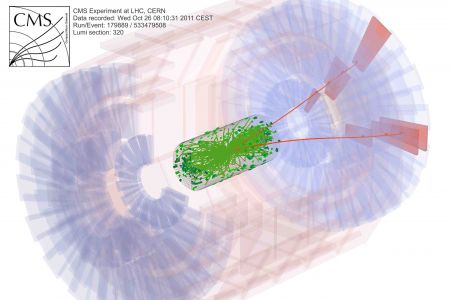
At a CERN seminar today, CMS presented results for the search for new physics in the decay of Bs and B0 mesons to two muons, taking into account all of the 4.9 fb−1 of data collected in 2011. The results — upper limits of 7.7 x 10−9 (Bs) and 1.8 x 10−9 (B0) at 95% confidence level[1] — are a significant improvement over those presented in July 2011 (see under Search for rare decays of Bs→μμ).
Looking for something new
The Standard Model has been a remarkably successful theory, but while a lot of the world’s attention has been drawn to the Higgs boson — the final missing piece of the Standard Model puzzle — physicists at the LHC are constantly searching for phenomena that will supersede the theory’s predictions and require a rethink of our understanding of Nature.
One of these searches is being performed at CMS by a group dedicated to the study of neutral B mesons – composite particles made of a ‘bottom’ and a ‘strange’ quark (Bs), or a ‘bottom’ and a ‘down’ quark (B0). These mesons are produced abundantly at the LHC and, being unstable particles, decay swiftly within CMS.
The fraction of the produced Bs and B0 mesons that decay into two muons is predicted very precisely by the Standard Model: around three in a billion and one in ten billion respectively. Any deviation from the predicted numbers could be due to a non-Standard-Model process or new particles. The Bs and B0 search channels are highly sensitivity to new physics and have small theoretical uncertainties.
The search continues
In the absence of significant deviations from the expectations, CMS previously presented one of the most stringent limits on non-Standard-Model influences on these decays at the EPS-HEP conference last July. In the latter half of 2011, the LHC operated with up to 20 simultaneous proton-proton collisions taking place inside CMS. The latest results presented today take into account data collected during this challenging period and show a marked improvement, thanks to the excellent performance of the CMS detector and the analyses teams involved.
With the LHC expected to deliver three times as much data in 2012 as last year, CMS will be in a position to measure whether the Standard Model predictions of the rare decay of Bs to two muons are indeed observed in the data, or will be able to quantify possible deviations from the predicted decay rates of the neutral B mesons.
More resources
- More Bs→μμ event displays
- All CMS Papers
- All CMS Physics Analysis Summaries
- All CMS results
- Images of real collisions in CMS
Footnotes:
[1] Confidence level is a statistical measure of the percentage of test results that can be expected to be within a specified range. For example, a confidence level of 95% means that the result of an action will probably meet expectations 95% of the time.
- Log in to post comments

